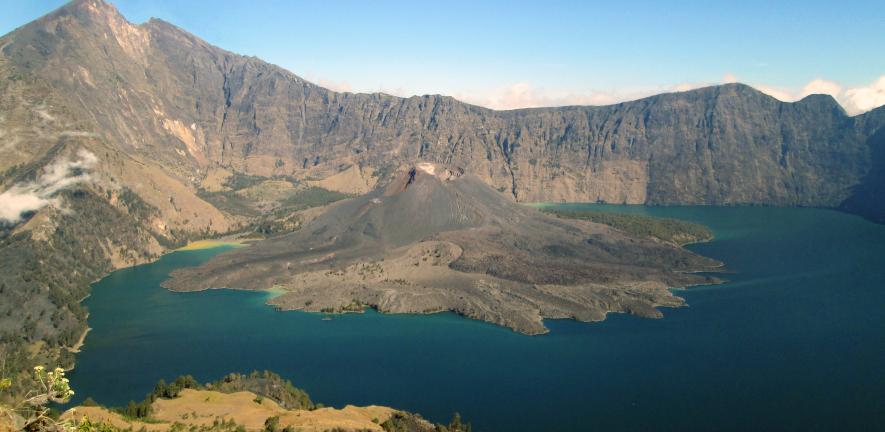
Volcanic eruptions not only have a huge impact on human lives but can also affect climate. Perhaps the most well known is the Mt Pinatubo eruption in 1991, which led to global cooling that lasted for around a year. For this reason, volcanic eruptions are a major area of research, and understanding their effects on the natural world remains a major priority.
Now in results published in PNAS, researchers from the University of Cambridge Centre for Atmospheric Sciences have collaborated with colleagues at the University of Cambridge Department of Geography, School of Earth and Environment at the University of Leeds, and the National Centre for Atmospheric Science to revisit the climatic impact of the largest eruption of the last millennium.
The 1257 Mt Samalas eruption released enormous amounts of gases into the atmosphere. Despite the well-documented catastrophic socio-economical consequences of the eruption, its impact on climate was not proportional to the magnitude of the eruption.
“The Mt Samalas eruption was a real mystery to the community,” said corresponding author Dr Alexander Archibald of this Department. “When co-author Dr Céline Vidal joined the Department of Geography, she quickly initiated a set of discussions on the potential chemistry-climate interactions, which led to this research."
Volcanic eruptions are complex because they inject a wide range of gases and particles into the atmosphere. For example, scientists know that Mt Samalas erupted in Indonesia in 1257, because they were able to detect deposits of sulfate aerosols trapped in ice cores. These were later confirmed by complex geochemical analysis of the productions of the eruption, which also revealed that Mt Samalas emitted a huge amount of ozone-destructive halogens into the atmosphere.
The researchers used computer models to determine the impact of the halogen and sulfur dioxide emissions from Mt Samalas, and to use this information to refine their climate models of future volcanic eruptions.
"Over the last few years, several studies have speculated that volcanic halogens released during eruptions would dramatically affect the ozone layer, with repercussions on the biosphere, but we found here that such an impact was very limited for the Mt Samalas eruption. The worst case scenario we simulated was inconsistent with both historical records of impacts and climate proxies such as tree rings. This confirms that there is still a lot to understand about the fate of halogen gases in volcanic fumes," said Dr Ward.
"We also found that, despite the fact that the 1257 Mt Salamas event was one of the largest eruptions to have occurred in human history, it caused a global cooling of 1 Co, an impact that was not proportional to its size,” said Dr Archibald, whose research focuses on developing complex climate simulations.
"The 1991 Mt Pinatubo eruption resulted in a global cooling of around 0.4 Co -- the Mt Samalas eruption was about ten times the size of Mt Pinatubo, so why didn't the climate cool by ten times that, which would be 4 Co? Well, our model shows that largely it's a result of the aerosol formation being dependent on how large the eruption is. There is a self-limiting effect which means that you get less "bang for your buck".
First author Dr David Wade and co-author Dr Luke Abraham, also from the Centre for Atmospheric Science, helped pioneer the development of the HadGEM3-ES Earth system model used in this study. This allowed the researchers to simulate aerosol microphysics and chemistry processes together with the full Earth system model. “Without these complex processes being simulated, we would have been unable to reconcile the effects of the Mt Samalas eruption,” said Archibald, who wants to encourage other groups around the world to use a similar modelling framework for future studies.
“It’s hard not to be fascinated by volcanoes. They are an incredible part of the Earth system, and as our group has increasingly moved to simulate this system with numerical models our interests have focused on problems that involve the interactions between atmospheric chemistry and climate. Our next steps are to understand how large volcanic eruptions may affect future climate, and the recovery of the ozone layer,” he said.
“We felt this was a great and exciting opportunity to look to the past, and that by understanding the past better we will be able to predict the future with improved confidence.”
“No one knows exactly when the next large volcanic eruption may happen, but our work has led us to have improved confidence in our ability to model the potential impacts of one of these events.”
Figure below shows model-simulated and reconstructed (tree ring) temperature for Northern Hemisphere land areas circa 1257 Mt Samalas eruption, from Wade et al. Their model simulations with small or no halogen emissions (BOTH-SO2) capture the relatively muted climate response recorded by the proxy date.

Research
Reconciling the climate and ozone response to the 1257 CE Mount Samalas eruption, David C.Wade, Céline M.Vidal, N. Luke Abraham, Sandip Dhomse, Paul T. Griffiths, James Keeble, Graham Mann, Lauren Marshall, Anja Schmidt and Alexander T. Archibald

